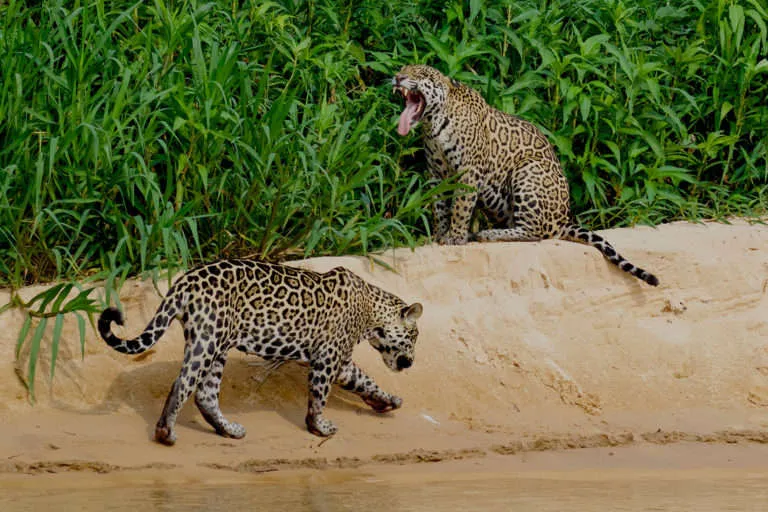Mexico, a nation celebrated for its rich culture, long history, and diverse natural landscapes, is also a captivating destination for wildlife enthusiasts. Over the past decade, Mexico has made significant strides in conserving endangered species, particularly the jaguar (Panthera onca), which was once severely threatened.
Biodiversity Conservation: Mexico’s Success Story
Mexico is not only culturally and historically rich but also a global biodiversity hotspot. With diverse ecosystems ranging from rainforests to deserts, Mexico is home to countless species of flora and fauna. However, rapid economic development and urbanization have placed significant pressure on its natural environment and wildlife.
Recognizing the importance of conservation, the Mexican government has implemented numerous effective conservation programs and policies, focusing on the establishment and management of wildlife reserves. These areas play a crucial role in protecting natural habitats, maintaining species populations, and promoting ecotourism.
Calakmul Biosphere Reserve: Yucatan Peninsula’s Gem
One of the most important protected areas in Mexico is the Calakmul Biosphere Reserve, located in the southern Yucatan Peninsula. This area is not only a UNESCO World Heritage site but also one of the largest protected tropical forests in Latin America.
In 2022, the Mexican government and the National Alliance for Jaguar Conservation planned to expand the Calakmul Biosphere Reserve from 723,185 hectares to over 1.3 million hectares. This expansion aims to make Calakmul the largest protected tropical forest north of the Orinoco River, providing immense benefits for biodiversity and the conservation of endangered species.
Calakmul is home to a variety of wildlife, including jaguars, howler monkeys, macaws, and numerous bird species. The area also boasts many archaeological sites of ancient Mayan civilization, creating a unique blend of nature and culture.

Jaguar Conservation Efforts: A Success Model
The story of the jaguar’s resurgence in Mexico is a testament to how conservation efforts can yield positive results. In the past, jaguars were among the most threatened carnivores in the Americas due to habitat loss, poaching, and human-wildlife conflict.
However, thanks to comprehensive conservation programs, jaguar numbers in Mexico have increased significantly in recent years. Data from two national surveys show that the jaguar population rose from 4,000 individuals in 2010 to 4,800 individuals in the second survey. This result demonstrates that Mexico’s conservation efforts are on the right track and delivering tangible results.
To achieve this success, the National Alliance for Jaguar Conservation has collaborated with the government, scientists, and local communities to implement various conservation measures, including:
- Habitat Conservation: Protecting and restoring critical jaguar habitats, especially migration corridors and wildlife reserves.
- Human-Wildlife Conflict Resolution: Supporting communities living near reserves to mitigate conflicts with jaguars, for example, compensating for livestock losses due to jaguar predation and providing electric fences to prevent jaguars from harming livestock.
- Community Awareness: Organizing education and outreach programs to raise public awareness about the importance of jaguar and other wildlife conservation.

Other Reserves and Species in Need of Protection
Besides Calakmul, Mexico has many other wildlife reserves, each with unique characteristics and species in need of protection. Here are a few examples:
- Sian Ka’an Biosphere Reserve: Located on the Caribbean coast of the Yucatan Peninsula, Sian Ka’an is a biodiverse reserve with mangroves, lagoons, and coral reefs. This area is home to numerous bird species, sea turtles, dolphins, and manatees.
- Monarch Butterfly Biosphere Reserve: Situated in the mountains of western Mexico, this reserve is where millions of Monarch butterflies migrate each year to breed. This is a remarkable natural phenomenon and a popular tourist attraction.
- Copper Canyon National Park: Located in the state of Chihuahua, Copper Canyon is a canyon system larger and deeper than the Grand Canyon in the United States. This area is home to diverse wildlife, including black bears, mountain lions, and coyotes.
Mexico is not only focused on jaguar conservation but also strives to protect many other endangered species, including sea turtles, gray whales, scarlet macaws, and Axolotls.
Ecotourism: Exploring Mexico’s Natural Beauty
Wildlife reserves in Mexico are not only places to protect natural habitats but also attractive destinations for ecotourism. Visitors can participate in activities such as hiking, bird watching, snorkeling, and exploring archaeological sites.
Ecotourism not only provides enjoyable experiences for visitors but also contributes to environmental conservation and local economic development. By supporting sustainable tourism activities, we can help protect reserves and ensure that wildlife continues to thrive in the future.
Conclusion
Mexico has demonstrated that wildlife conservation is entirely possible with commitment and effort from the government, scientists, and local communities. Wildlife reserves in Mexico are not only havens for endangered species but also symbols of hope and inspiration for other nations worldwide. Come and explore the unique natural beauty of Mexico, and join hands in protecting our planet!